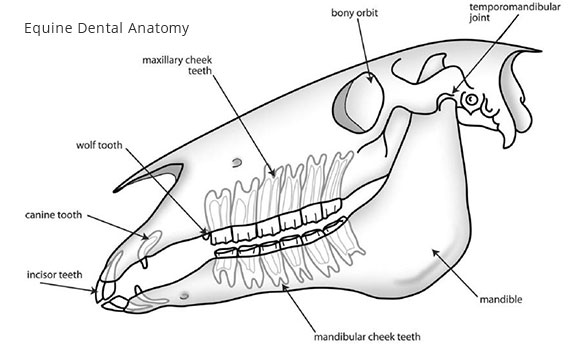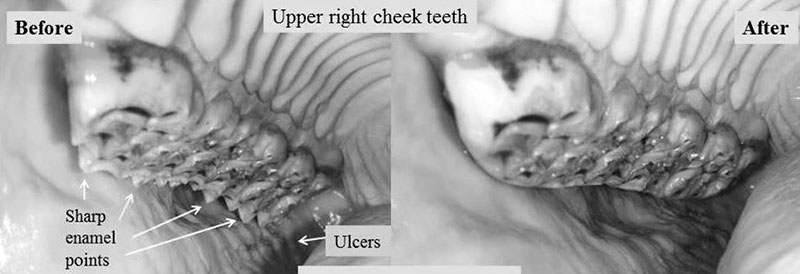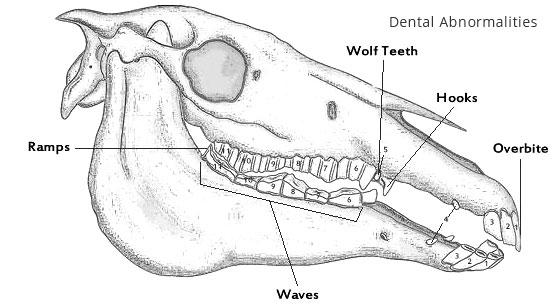Equine Dentistry
Dentistry, including major dental work
By Dr. Michelle Wiberg

Equine dentistry, or the practice of floating a horse’s teeth, is a fundamental part of every horse’s routine veterinary care. Floating a horse’s teeth involves filling down the sharp enamel points that naturally develop over time as the horse chews. Horses’ teeth continue to erupt throughout life and teeth are worn down by contacting and grinding against the opposing teeth. Because horses’ upper jaws (maxilla) are wider than their lower jaws (mandible), the outer aspect of the upper teeth and the inside surface of the lower teeth do not directly contact the opposing teeth. As the horse chews, the result is the formation of enamel points that, if left unaddressed, can lead to ulceration of the cheek and tongue. These sores can cause pain during eating or biting problems when ridden. New points can develop in a matter of months. Horses should be checked for points and floated every 1-2 years.
 Commons signs owners may see when their horse is experiencing dental discomfort include tilting their head to one side when eating, quidding hay or dropping grain out of their mouth when chewing, foul smelling breath or nasal discharge, refusing to accept the bit, problems when working in a bit, head shaking, and weight loss. Some horse may have difficulty maintaining body condition due to dropping of feed and reduced feed utilization. Feed utilization may be decreased due to the inability to mechanically break down feed material into a short enough stem length or particle size required for optimal digestion. Poorly chewed feed can also lead to intestinal impactions and colic or esophageal choke. Horse’s teeth should be checked at least once yearly, even if you do not notice any problems. Currently, annual dental floats are recommended to prevent the development of sharp points and hooks and to monitor for other signs of dental disease.
Commons signs owners may see when their horse is experiencing dental discomfort include tilting their head to one side when eating, quidding hay or dropping grain out of their mouth when chewing, foul smelling breath or nasal discharge, refusing to accept the bit, problems when working in a bit, head shaking, and weight loss. Some horse may have difficulty maintaining body condition due to dropping of feed and reduced feed utilization. Feed utilization may be decreased due to the inability to mechanically break down feed material into a short enough stem length or particle size required for optimal digestion. Poorly chewed feed can also lead to intestinal impactions and colic or esophageal choke. Horse’s teeth should be checked at least once yearly, even if you do not notice any problems. Currently, annual dental floats are recommended to prevent the development of sharp points and hooks and to monitor for other signs of dental disease.
Some horses may require more frequent dental floating, especially if bite abnormalities are noted, such as an overbite (parrot mouth), underbite (monkey mouth), or an especially narrow lower jaw in relation to the upper jaw. Bite abnormalities can lean to more rapid development of points and hooks. Geriatric horses should be evaluated for loose teeth that may require pulling. Once a horse begins to loose teeth, a dental float should be performed at least yearly to prevent overgrowth of teeth that no longer have an opposing tooth to wear against. Young horses should be evaluated for loose caps (baby teeth) and for the presence of wolf teeth that are frequently removed to prevent interference with the bit.
 Today, motorized dental floats are the standard and the norm. Horses are safely sedated, a full mouth speculum is placed, and the horse’s head is either slung in a specialized dental halter or placed on a dental stand. Power dental floats allow for a quick reduction of points and other abnormalities such as hooks, ramps, steps, and waves. Equine dental floats must be performed by a licensed veterinarian or under the direct supervision of a veterinarian.
Today, motorized dental floats are the standard and the norm. Horses are safely sedated, a full mouth speculum is placed, and the horse’s head is either slung in a specialized dental halter or placed on a dental stand. Power dental floats allow for a quick reduction of points and other abnormalities such as hooks, ramps, steps, and waves. Equine dental floats must be performed by a licensed veterinarian or under the direct supervision of a veterinarian.
